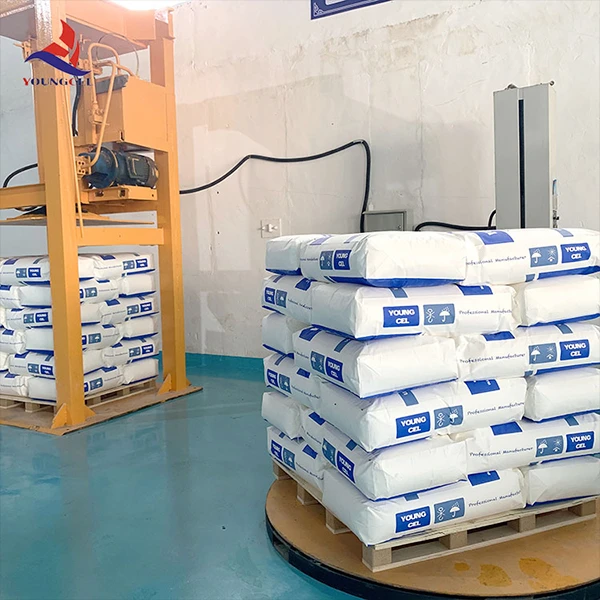Understanding HPMC Tile Adhesive A Comprehensive Overview
In the modern construction landscape, tile installation has emerged as a vital element in both residential and commercial spaces. With the ever-increasing demand for quality and durability, tile adhesives have become sophisticated, giving rise to specialized products such as Hydroxypropyl Methylcellulose (HPMC) tile adhesive. This article explores the composition, benefits, applications, and considerations of HPMC tile adhesive for both professionals and DIY enthusiasts.
What is HPMC?
Hydroxypropyl Methylcellulose is a semi-synthetic polymer derived from cellulose, a natural polymer found in plant cell walls. Through a series of chemical processes, cellulose is modified to enhance its properties, resulting in a product that is both versatile and effective as an adhesive. It is widely used in various industries, ranging from pharmaceuticals to construction, due to its excellent binding, thickening, and film-forming properties.
Composition of HPMC Tile Adhesive
HPMC tile adhesives typically consist of the following components
1. HPMC Polymer This is the primary binding agent that provides the adhesive properties. Its unique structure allows it to retain water, providing enough working time to adjust tiles during installation.
2. Aggregate Materials These include sand and other fillers that enhance the bulk and stability of the adhesive. The selection of aggregate depends on the specific requirements of the installation.
3. Additives Various chemical additives may be included to improve properties such as adhesion, flexibility, and resistance to environmental factors like moisture and heat.
4. Water Water is essential for mixing the adhesive and activating the HPMC component, allowing it to glide smoothly and bond effectively to surfaces.
Benefits of HPMC Tile Adhesives
HPMC tile adhesives offer numerous benefits that make them a preferred choice among builders and contractors
1. Enhanced Workability HPMC provides an extended open time, giving users more flexibility during installation. This feature allows for adjustments to be made before the adhesive sets, ensuring precise tile placement.
2. Superior Bond Strength The adhesive creates a strong bond with various substrates, including ceramic, porcelain, glass, and natural stone tiles. This characteristic is vital for ensuring that tiles remain securely in place over time.
3. Water Retention HPMC possesses excellent water-retention properties, which prevents premature drying and allows for better hydration of the cementitious materials. This leads to improved curing and bond strength.
hpmc tile adhesive

4. Resistance to Cracking and Shrinkage HPMC-modified adhesives tend to exhibit lower shrinkage during drying. This minimizes the risk of cracking, making it suitable for both wet and dry areas.
5. Eco-Friendly Option Since HPMC is derived from natural cellulose, it aligns with the growing trend towards sustainable construction materials. Its use can contribute to a lower carbon footprint in building projects.
Applications
HPMC tile adhesives are suitable for a variety of applications, including
- Floor and Wall Tile Installation Whether for residential, commercial, or industrial projects, HPMC adhesive can be used for installing tiles on floors and walls.
- Wet Areas Its water-resistant properties make it ideal for bathrooms, kitchens, and other areas exposed to high moisture levels.
- Exterior Applications HPMC-based adhesives can be used for external cladding and tiling, where resistance to environmental conditions is crucial.
Considerations for Use
While HPMC tile adhesive is highly beneficial, there are a few considerations to keep in mind
1. Surface Preparation Proper surface preparation is crucial for maximizing adhesion. Surfaces should be clean, dry, and free from contaminants such as dust, grease, or old adhesive residues.
2. Mixing Guidelines It is essential to follow manufacturer instructions when mixing HPMC adhesives with water to achieve the desired consistency and performance.
3. Curing Time Different types of HPMC adhesives may have varying curing times; therefore, it’s important to be aware of these timelines before proceeding with grouting or finishing.
4. Suitability Not all HPMC adhesives are suitable for every type of tile or substrate. Always check compatibility to avoid issues during installation.
Conclusion
HPMC tile adhesive represents a significant advancement in tile installation technology. Its combination of excellent adhesive properties, ease of use, and environmental sustainability make it an attractive choice for various installation projects. Whether you're a professional contractor or a DIY enthusiast, understanding HPMC tile adhesive can greatly enhance your tile installation experience, ensuring a durable and aesthetically pleasing finish. As the construction industry continues to evolve, HPMC will likely play a crucial role in shaping future building practices.
-
A Comprehensive Guide to Methyl Ethyl Hydroxyethyl Cellulose: Applications and Industry InsightsNewsNov.24,2025
-
Understanding Methyl 2 Hydroxyethyl Cellulose: Uses, Benefits & Industry InsightsNewsNov.24,2025
-
Hydroxyethyl Methyl Cellulose HEMC: Industrial Uses, Benefits & Future TrendsNewsNov.23,2025
-
HEMC Cellulose: Versatile & Sustainable Industrial Polymer | YoungcelNewsNov.23,2025
-
Methyl Hydroxyethyl Cellulose: Versatile Building Block for Industry & SustainabilityNewsNov.23,2025
-
CAS 9032 42 2: Understanding Polyvinyl Alcohol's Impact on Industry & SustainabilityNewsNov.22,2025




